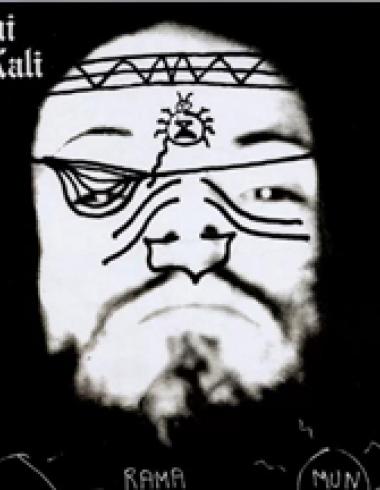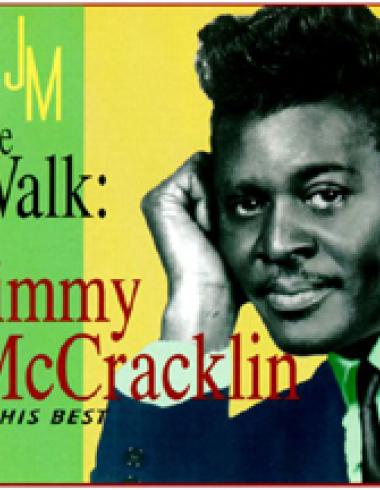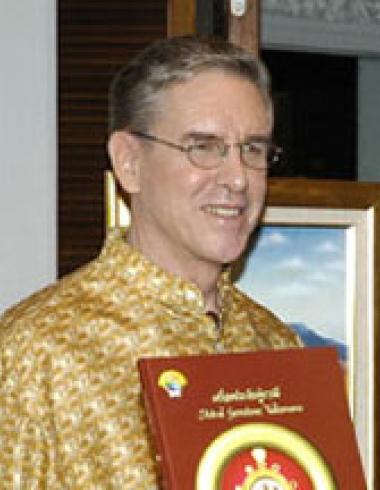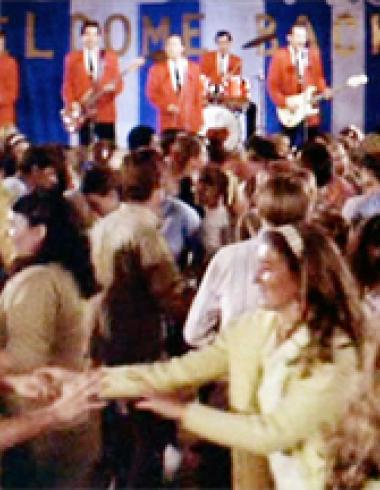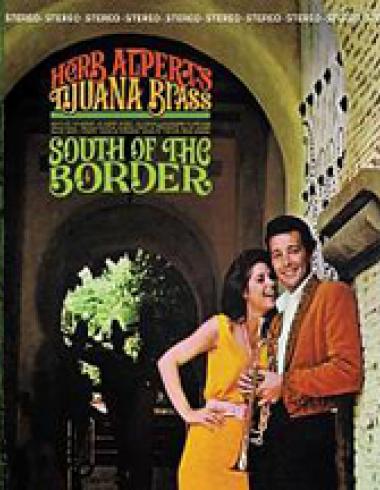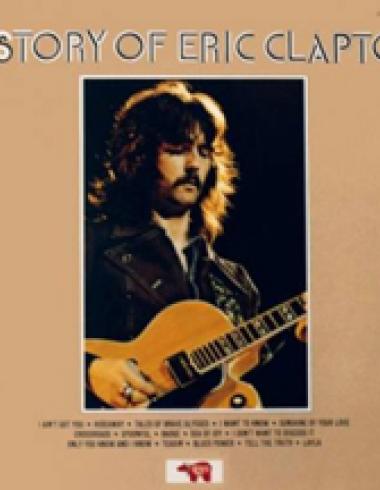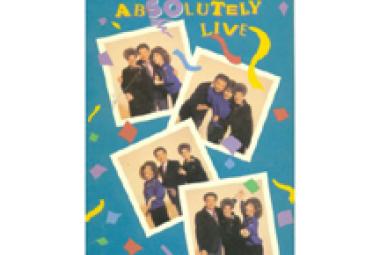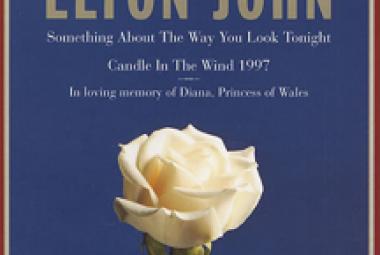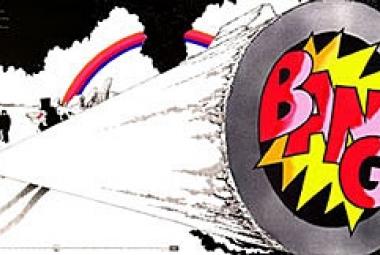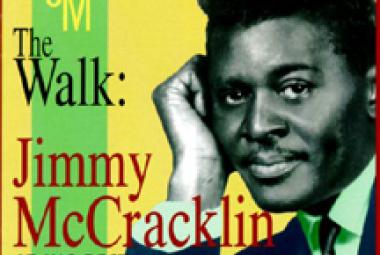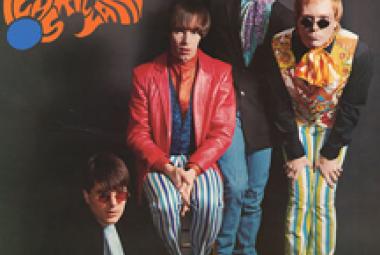The Beatles were an English rock band that formed in Liverpool in 1960. With members John Lennon, Paul McCartney, George Harrison and Ringo Starr, they became widely regarded as the greatest and most influential act of the rock era. Rooted in skiffle, beat and 1950’s rock and roll, the Beatles later experimented with several genres, ranging from pop ballads and Indian music to psychedelic and hard rock, often incorporating classical elements in innovative ways. In the early 1960’s, their enormous popularity first emerged as “Beatlemania”, but as the group’s music grew in sophistication, led by primary songwriters Lennon and McCartney, they came to be perceived as an embodiment of the ideals shared by the era’s sociocultural revolutions. (More from Wikipedia)
You can talk about your pioneers of rock and roll – Chuck Berry, Little Richard, Elvis Presley, James Brown, just to name a few – and you can even bring up your British Invasion greats – the Beatles, the Rolling Stones, the Animals, the Yardbirds, the Kinks, just to name another few. All of them are already in the Rock & Roll Hall of Fame, and deservedly so. However, you can play a lot of more modern rock records all day long and not really discern more than a hint of their direct influence; no question it’s in the DNA, but actual Elvis Presley-style vocals or Chuck Berry guitar licks or James Brown wails are elusive.
That is not so with Link Wray: His influence is front and center on a good 50% of the records that I play, because he is credited with introducing the “power chord” on electric guitar to rock and roll, a technique whose effect is often enhanced by distortion.
Other 1970’s recordings have danced around gay issues, such as Rod Stewart’s 1976 minor hit “The Killing of Georgie” – about the murder of a gay friend of his in New York back when he was in Faces – and it was an open secret that Freddie Mercury was gay though closeted; he was the frontman of a band called Queen after all. It was many years later though before openly gay songs and performers would arrive on the popular music scene, such as British musician Tom Robinson in the late 1970’s (he collaborated with Peter Gabriel on one EP that I own), and mid-1980’s sensation Frankie Goes to Hollywood. By the way, it is interesting that the first hit songs by arguably the two most famous Liverpool rock bands – the Beatles’ “Please Please Me” and Frankie Goes to Hollywood’s “Relax” – deal fairly openly with the topic of oral sex.
* * *
After a few gigs with the Sands Combo and the Interns in 1963 (not the same as the Welsh band called the Interns that was active from 1964 to 1967), the Giles Brothers played the longest (“758 gigs played”) with a band called Trendsetters, Ltd., from 1964 to 1967. They released four singles on Parlophone Records (the Beatles’ label in the UK). After guitarist/vocalist Bruce Turner left the band in 1967 to join the Loot, the band continued to record under the names the Trend and the Brain.
(March 2013)
* * *
The Beatles are well known for honing their craft in the clubs of Hamburg, Germany in the very early 1960’s, as well as in their hometown of Liverpool. Still, there was some question back then as to whether they could be successful selling records in a non–English-speaking country, so the Fab Four were cajoled by their manager Brian Epstein and their producer George Martin into recording German-language versions of two of their biggest hits, “I Want to Hold Your Hand” and “She Loves You” in January 1964. “Komm, Gib Mir Deine Hand” was later released on the band’s American album, Something New about six months later.
The second Les Sinners album (which was produced by Pierre Noles) had practically the same name as the first – Sinnerismes (“Sinnerisms”), but with a second “n” this time – and saw the band essentially abandoning the English language for most of the rest of their career (though several of the song titles were still in English). Album highlights include a French-language version of the Beatles hit “Penny Lane”, “Les Disc-Jockeys”, and several weird psychedelic tracks like “L.S.D. Ha! Ha!”.
* * *
The next album by Les Sinners (though with the name shortened to just Sinners) for Jupiter, Vox Populi (Latin for “Voice of the People”) came out in 1968 and is among the crush of “concept albums” that followed in the wake of the Beatles’ 1967 masterpiece, Sgt. Pepper’s Lonely Hearts Club Band. The album has acquired legendary status among fans of Quebec’s musical scene. The album is entirely in French and is probably the first and certainly one of the best French Canadian concept albums ever released. A whole barrel of musical influences are present: the Beatles, the Monkees, the Byrds, the Who, Indian music, etc. The cover appears to show Jesus speaking in a snowy cemetery.
(April 2013)
I was born a couple of years later than Greg Shaw, so I turned 14 in 1965. By then, the Beatles and the Rolling Stones were old news; and while I was still paying attention, what was really grabbing me at the time were American artists and bands. First and foremost was “Like a Rolling Stone” by Bob Dylan; that song – plus the flip side “Gates of Eden” that was nearly as long and every bit as good – captivated me in a way that I just couldn’t keep quiet about. Other great folk-rock sounds of that period included the release of the cover of Dylan’s “Mr. Tambourine Man” by the Byrds and the revamped “The Sounds of Silence” by Simon and Garfunkel. Bob Dylan himself preferred the Byrds’ cover to his own recording of “Mr. Tambourine Man”; but in my usual contrarian way, I preferred Dylan’s original – it was a lot longer for one thing.
These songs were followed closely by the glorious sounds of garage rock and psychedelic rock that were then in their infancy. Songs like “Pushin’ Too Hard” by the Seeds, “We Ain’t Got Nothin’ Yet” by Blues Magoos, and “I Had Too Much to Dream (Last Night)” by the Electric Prunes really made an impression on me. It wasn’t until I picked up the Nuggets collection and then the numerous Pebbles albums that I plumbed the depths of this scene, but it was by no means brand new to me either.
The promotional material on the band by Alive Records lays out their basic template: “Taking cues from classic pop, rock ’n’ roll, and Americana, Hollis Brown combines raw rock sensibilities with sweet melodies and heartfelt lyrics to create a rich, warm sound that can fill any room. . . . You’d be hard-pressed to find a Beatles song these boys don’t know by heart, and you can hear it in the music. Classic rock with a New York state of mind, Hollis Brown is a throwback to an era when music felt fresh, songwriting was revered, and performances routinely inspired.”
(May 2013)
But there is no shortage of interpretations of “American Pie” from all quarters (I took a stab at it myself ages ago): Bob Dylan is said to be the “jester”; the Beatles are evidently referenced in the line “sergeants played a marching tune”; and the Rolling Stones (Mick Jagger in particular) seem to have a more central role in the tale – the fifth verse includes the lyric “Jack be nimble, Jack be quick / Jack Flash sat on a candlestick” (an obvious reference to the Rolling Stones hit “Jumpin’ Jack Flash”), several mentions of Satan (“Sympathy for the Devil” is one of several times that the Stones toyed with Satanic imagery), and apparent veiled references to the horrific Altamont Speedway Free Concert that occurred on the heels of Woodstock on December 6, 1969, where the Rolling Stones were the featured act, and the Hells Angels motorcycle club provided security.
* * *
The impact of this one Elvis recording can hardly be overstated. “Heartbreak Hotel” was one of the biggest influences on John Lennon that inexorably led to the formation of the Beatles.
* * *
Sister Rosetta Tharpe is the only woman mentioned in the Wikipedia list, but she is not the only one that I have heard talked about. Rosemary Clooney had one of her biggest hits with “Hey There” b/w “This Ole House”; both songs individually reached #1 in 1954 on the Billboard singles charts (in case you think – as I had – that the Beatles were the first to have double-sided #1 hit singles).
* * *
While not at all minimizing the contributions of the legends that I have discussed thus far, my own nominee for the man who most directly congealed a variety of musical ingredients into what we know today as rock and roll is Chuck Berry. Berry’s classics like “Maybellene” (1955), “Rock and Roll Music” (1957) and “Johnny B. Goode” (1958) sound as fresh to my ears today as they did the first time I heard them more than 50 years ago. His 1956 hit “Roll Over Beethoven” – “Roll Over Beethoven” also might be my very favorite Beatles cover song – contains a truly delicious song lyric: “Roll over [in your grave], Beethoven / And tell Tchaikovsky the news”.
* * *
Writing for Allmusic, rock critic Bruce Eder states his case well: “Buddy Holly is perhaps the most anomalous legend of ’50s rock & roll – he had his share of hits, and he achieved major rock & roll stardom, but his importance transcends any sales figures or even the particulars of any one song (or group of songs) that he wrote or recorded. Holly was unique, his legendary status and his impact on popular music all the more extraordinary for having been achieved in barely 18 months. . . . In a career lasting from the spring of 1957 until the winter of 1958-1959 – less time than Elvis had at the top before the army took him (and less time, in fact, than Elvis spent in the army) – Holly became the single most influential creative force in early rock & roll. . . .
“Holly and the band weren’t afraid to experiment even on their singles, so that ‘Peggy Sue’ made use of the kind of changes in volume and timbre on the guitar that were usually reserved for instrumental records; similarly, ‘Words of Love’ was one of the earliest successful examples of double-tracked vocals in rock & roll, which the Beatles, in particular, would embrace in the ensuing decade.”
* * *
More than a few British rock groups adopted band names in tribute to Buddy Holly. The Beatles in part took their insect-oriented name from that of his band the Crickets. One Manchester band of the British Invasion period simply called themselves the Hollies. Yet another British Invasion band, the Searchers took their name from the John Wayne movie of that name, The Searchers, where the Duke often said, “That’ll be the day”; the catch phrase had been adopted by Buddy Holly as the name of one of his first hits, “That’ll Be the Day”.
* * *
The above disk is of Buddy Holly’s song “That’ll Be the Day” and is the first recording that was made by the Quarrymen, the skiffle band that later became the Beatles. Intended only as a demonstration disc, just one copy was ever pressed (in 1958); this record is one of the most valuable on earth, worth an estimated £100,000 according to NME.com. The song was officially released in 1995 on the Beatles’ Anthology 1 retrospective album package.
* * *
Both Paul McCartney and John Lennon have called Buddy Holly a primary influence on their work; Ian Whitcomb once said that “Buddy Holly and the Crickets had the most influence on the Beatles.” The Beatles did a lovely cover of “Words of Love” that was released in late 1964 on their album Beatles for Sale. During the recording sessions for the Let it Be album in January 1969, the Beatles recorded a slow version of “Mailman, Bring Me No More Blues” (a song popularized by Buddy Holly, though not written by him); the song was later released on Anthology 3. Also, John Lennon recorded a cover of “Peggy Sue” on his 1975 solo album Rock ’n’ Roll.
* * *
Little Richard started edging back into rock and roll in 1962; a European tour with Sam Cooke where he sang his gospel material was not well received, but crowds enthusiastically applauded his older songs like “Long Tall Sally”, a song that the Beatles recorded in full-blown Little Richard style in 1964, with Paul McCartney on lead vocals. The same year, Little Richard unapologetically returned to rock and roll and released “Bama Lama Bama Loo” in 1964; however, public tastes had changed, and he spent much of the 1960’s and 1970’s in what should have been unnecessary self-promotion.
(June 2013/1)
* * *
Brian Wilson was the bandleader and primary songwriter of the Beach Boys; writing for Allmusic, William Ruhlmann says that Brian Wilson “is arguably the greatest American composer of popular music in the rock era”. In the beginning, there were fun songs about surfing and cars and girls, as well as a (more or less) friendly rivalry with Jan & Dean that prefigured the more contentious Beatles vs. Stones debates. It is no secret that Jan Berry – a wunderkind in his own right – wasn’t happy that the Beach Boys copied the surf sounds that Jan & Dean pioneered.
* * *
Anyway, in its initial release in October 1964, Wednesday Morning, 3 A.M. was unsuccessful, possibly overshadowed by the Beatles. Of one song on the album, “The Sounds of Silence” – performed acoustically, like all the rest – Art Garfunkel wrote in the liner notes: “‘The Sounds of Silence’ is a major work. We were looking for a song on a larger scale, but this is more than either of us expected.”
* * *
“The Sounds of Silence” began climbing the charts and was the #1 single in the country for the first three weeks of 1966 (sandwiched between a Dave Clark Five song and a Beatles song).
(June 2013/2)
* * *
It was like that about the Klubs also. Despite having a strong local following in Liverpool for several years, the home city of the Beatles f’crying out loud, the band had faded into complete obscurity.
* * *
Part of the reason has to do with the Liverpool music scene in the 1960’s: Other than you-know-who, most of the big British Invasion bands came from somewhere else. The Beatles’ early competitors on the American charts were the Dave Clark Five; their first big hit song “Glad All Over” hit the Top Ten in February 1964, though the Five wouldn't make #1 until “Over and Over” came out in November 1965. The Dave Clark Five were from North London and were being promoted as the progenitors of the “Tottenham Sound”.
Though only one of the big acts came from there, other 1960’s bands were based in Liverpool. Gerry and the Pacemakers is likely the best known; like the Fab Four, this band was managed by Brian Epstein, and their records were produced by George Martin. Their American hits include “Don’t Let the Sun Catch You Crying” and “Ferry Cross the Mersey”, a reference to the Mersey River that runs by the city – in case you are wondering why there has always been so much “Mersey” talk surrounding the Beatles.
The Searchers is another Liverpool band that had numerous hits in the U.K., though they were less successful in the U.S.; their biggest hit songs here were remakes of “Love Potion No. 9” and “Needles and Pins”. The Swinging Blue Jeans barely missed the U.S. Top 20 with their cover of “Hippy Hippy Shake”, which was also recorded by the Beatles. Others include the Cryin’ Shames (not to be confused with the Cryan’ Shames, an American band from the same time period), the Merseybeats, the Hideaways, the Koobas (also known as the Kubas), and one of the first all-female rock bands, the Liverbirds.
* * *
But mostly the Klubs began establishing themselves as a leading band in the post-Beatles Merseyside scene. They were fixtures at the legendary Cavern Club; the Hideaways boasted more dates there (over 250 appearances) than the Beatles themselves, but the Klubs are ranked #3 in that regard. After they signed a management contract with Cavern Enterprises, the Klubs were beginning to perform more original material; as a harmonica player, Alan Walker became sort of a sixth wheel in the Klubs and moved on.
* * *
In July 1967, the Klubs were given a recording test at EMI’s famed Abbey Road Studios, renamed for the Beatles’ penultimate album, Abbey Road in 1970. Staff producer Alan Paramor oversaw a marathon recording session, where the Klubs worked on covers of Cream’s “NSU”, and “Desdemona” by John’s Children (back when Marc Bolan, later of T. Rex was a bandmember), plus a new recording of their own song “Livin’ Today”. Paramor called the band “unrecordable” and sent them on their way.
* * *
After auditioning the Klubs at a nightclub called the Pink Flamingo, Vic Smith signed them to a management deal with Don Arden’s company Aquarius. As a result, in early 1968, the Klubs again sort of followed in the Beatles’ footsteps and arrived at Decca Records – actually, Decca had famously decided against signing the Fab Four – where four tracks were laid down according to company records. Two were covers of the Beatles’ “Drive My Car” and Jimi Hendrix’s “Fire” – the latter song (apparently recorded at a later time) is the only cover song on the Midnight Love Cycle CD – plus their own songs “Midnight Love Cycle” and “Ever Needed Someone”. “Midnight Love Cycle” also became the title of their retrospective albums.
* * *
Don Arden insisted that the Klubs change their name to Revolution – perhaps he got the idea from another single by Tomorrow called “Revolution” that came out the year before the song of that name, “Revolution” by the Beatles. When the band refused to bow to this demand and arrogantly stood their ground, Arden heaped abuse on the young bandmembers. Don Arden, who was once called “the Al Capone of pop” by critic Johnny Rogan, was not used to taking any lip from the bands that he signed; Arden tore up their recording contract in front of the Klubs and vowed that their Decca recordings would never see the light of day.
(July 2013)
* * *
Johnette Napolitano and another member of Concrete Blonde, Jim Mankey actually contributed quite a bit to the Dr. Crow album: Jim Mankey played bass on their version of the Beatles’ classic “Strawberry Fields Forever”.
* * *
Much of the overheated rhetoric about J. Reuben Silverbird is about his name changes; even the minor switch from Ruben to Reuben is mentioned. Using stage names is hardly limited to rock musicians – the very term itself shows that its origin is in the theatre. You needn’t go any further than the drummer for the Beatles to find one: Ringo Starr (born Richard Starkey). Guitarist and songwriter Keith Richards of the Rolling Stones used the name Keith Richard for many years. The John Birch Society called Stones frontman Mick Jagger “Mick Jaeggert” back in the 1970’s; a Google search brought up only two websites using this name – one French and one Hungarian – so this is probably not for real.
* * *
This photograph of the Coronados with Jack Spector, a prominent New York City disc jockey on WMCA, was published in Billboard Magazine in 1965. (Spector is notable for having been the first DJ in New York to play the Beatles’ initial Capitol Records single, “I Want to Hold Your Hand” in late December 1963). Their music is described in the Daily Herald article mentioned previously in this way: “The mode became eclectic – show tunes, popular numbers – with a professional gloss appropriate to the Borscht Belt and other resort circuits.”
Meanwhile, the four teenaged children of the bandmembers in the Coronados – who sometimes appeared with their parents on stage – were being attracted to rock music and began singing and performing together as the Real Americans.
(August 2013)
Phil Spector’s work with the Beatles on their final album, Let it Be is more controversial, with many contending that it was more overproduction than production in that case. Ultimately, the album was re-released in 2003 without Spector’s production and overdubs under the name Let it Be . . . Naked. Still, Phil Spector worked with John Lennon on several of his solo albums.
* * *
The Beatles performed a sort of mini-Wall of Sound at the close of their masterful Sgt. Pepper’s Lonely Hearts Club Band album, not long after Phil Spector came along. Following the second symphonic build-up within “A Day in the Life”, the orchestra swelled into a crescendo, and then there was a thunderous piano chord (an E-major chord to be exact). Many people who have been around a piano marvel at how long the instrument can hold a note; and here, the Beatles were dealing that expectation up in spades with a long, slow fade for nearly one full minute before the sound faded into background hiss.
Actually though, it wasn't just one piano: John Lennon, Paul McCartney, Ringo Starr, and one of the Beatles’ roadies, Mal Evans were manning different pianos; while George Martin was playing the same chord on a harmonium. What’s more, the gain was gradually turned up as the chord faded in order to prolong the effect – at the end (they tell me), it is possible to hear background sounds in the recording studio: rustling papers, a squeaking chair, and the air conditioners.
* * *
The Goldie and the Gingerbreads 1964 recording of “Can’t You Hear My Heartbeat” made it to #25 in the UK. Here in this country, Herman’s Hermits released “Can’t You Hear My Heartbeat” two weeks earlier; the heavy promotion of that song cut them out of the U. S. charts. After meeting Eric Burdon and the Animals, Goldie and the Gingerbreads was signed for a European tour, where they performed with the Who’s Who of the British Invasion: the Beatles, the Rolling Stones, the Animals, the Yardbirds, the Hollies, the Kinks, and others.
* * *
“Fanny” is an interesting slang term: Here in North America, the reference is to the buttocks (hence the cover shot on their first album, Fanny); but in the British Commonwealth, it means the female vulva. Former Beatle George Harrison is the one who suggested the name Fanny to producer Richard Perry; the bandmembers themselves were not aware of its meaning on the other side of the Atlantic Ocean until much later.
* * *
The Music Emporium album opens with “Nam Myo Renge Kyo” that features chants of the Buddhist mantra that forms the title, along with psychedelic-style lyrics in the manner of the Beatles’ “Lucy in the Sky with Diamonds”. “Catatonic Variations” features an atonal structure that was just coming into vogue in the classical world, if I am remembering that correctly. The album closes with the obligatory protest song, “Day of Wrath” that features the tag lyric: “There is no question that there will be peace on earth / But will man be here to enjoy it”.
(October 2013)
The Mamas and the Papas are another band featuring both men and women that had enduring popularity throughout the British Invasion years. They were also one of the first American bands that fans began to know individually the way they knew the Beatles: Suave bandleader John Phillips, his gorgeous wife Michelle Phillips, the muscular singer Cass Elliot (who became known almost immediately as “Mama Cass”), and Denny Doherty, the other Papa.
* * *
Cheap Thrills was a true sensation – as happened so often with the Beatles, Big Brother and the Holding Company staked out territory on this album that other rock artists could only admire; no one tried to follow them. The front cover art by top “underground comics” artist R. Crumb still looks amazing; almost as well known is the dramatic pose by Janis Joplin on the back cover.
* * *
Patti Smith began performing rock music in 1974 – another year that popular music changed irrevocably, much like 1963 with the Beatles and the rest of the British Invasion – with music archivist and guitarist Lenny Kaye. While not actually inventing the term “punk rock”, he had popularized it in his liner notes for the first compilation album of garage rock and psychedelic rock music, Nuggets, so this was most appropriate.
(February 2014)
* * *
After Twink left the band, the remaining trio in the Pink Fairies recorded What a Bunch of Sweeties which includes another song on my All-Time Top Ten, “Marilyn”. This album was at the top of my Want List for decades before I finally mail-ordered a copy – just in time for Hurricane Katrina. The album also includes covers of two familiar 1960’s tracks: the Beatles’ “I Saw Her Standing There” and the instrumental “Walk, Don’t Run” (originally by the Ventures). As described by Wikipedia: “The sleeve came in a gatefold cover by Edward Barker, the front showing a box full of goodies mostly taken from roadie David “Boss” Goodman’s personal collection of underground badges etc.” The album is mostly a sonic assault that also includes the playful song “Pigs of Uranus” – but even that song ends with a fabulous electric guitar solo.
In 1969, Mick Farren “liberated” the earliest large-scale rock concert in the U.K., the 1969 Isle of Wight Festival by encouraging the fences to be torn down. This concert – which took place the month after Woodstock (and with many of the same acts) – featured the Who, the Band, Free, Joe Cocker, and the Moody Blues. But the real excitement was caused by the inclusion on the bill of Bob Dylan, who had been little seen since his near-fatal motorcycle accident in July 1966. When Dylan took the stage, audience members included three of the Beatles, three of the Beatle wives, three of the Rolling Stones, Eric Clapton, Liz Taylor, Richard Burton, Jane Fonda, Roger Vadim, Syd Barrett, and Elton John.
One of the main reasons for the location of the original Woodstock was to lure Bob Dylan out of hiding – the idea was to throw a huge party practically on his doorstep that surely he couldn’t resist attending. Woodstock is the name of the town where Dylan lived (and also members of the Band); the festival itself was in Bethel. But resist he did; Bob Dylan instead signed up to appear at the Isle of Wight Festival and set sail for England on August 15, 1969, the day that Woodstock opened.
For their second single, they moved to another EMI label, Parlophone Records (the Beatles’ record company in Britain) and adopted a more pop-oriented sound reminiscent of another Parlophone band, the Hollies, releasing “I, I, I Want Your Lovin’” b/w “She Only Wants a Friend”. For the final single by the Sons of Fred for Parlophone in 1966, they went back to R&B for “Baby What You Want Me To Do” b/w “You Told Me”.
(March 2014/2)
* * *
So you want to be a rock ’n’ roll star
Then listen now to what I say
Just get an electric guitar
And take some time and learn how to play
And when your hair’s combed right and your pants fit tight
It’s gonna be all right
So said the Byrds – specifically songwriters Jim McGuinn and Chris Hillman – back in 1967, and the formula still works pretty well to this day.
The lyrics are more than a little cynical – check the next to last line – and the fact is, no one has really discovered the secret formula. “So You Want to be a Rock ’n’ Roll Star” was written in the wake of the creation of The Monkees television show and the Monkees band, who became known by many as the Pre-Fab Four (the Beatles of course being the original Fab Four).
* * *
Small Faces’ response to the Beatles’ Sgt. Pepper album was a remarkable psychedelic achievement called Ogdens’ Nut Gone Flake; the album was originally released in a round cover and had the appearance of a vintage tobacco tin. And I sure wish it would show up from the LP’s in the Katrina mud that I still haven’t cleaned up, because I miss it!
* * *
By contrast, the people at Gear Fab Records – one of the better reissue record companies – are quite enthusiastic about Homer; Galen Niles was brought in to write the liner notes for the 2012 CD, Homer. (The record company name comes from two Beatles-era expressions for “cool”; both are featured in the background singing on “All Those Years Ago”, the 1981 George Harrison song honoring recently assassinated John Lennon and also featuring the other two living Beatles in the band).
(April 2014)
* * *
Running down something like this for a major rock band like the Beatles or Led Zeppelin would be difficult enough; but I can’t imagine where he even looked, a half-century later, to find out about every gig of the Soul Agents (18 in the month of August 1964 alone, to pick one month basically at random). Bruno Ceriotti noted that one club where the band performed regularly, the Marquee in Soho did not normally list the supporting acts in their monthly program listings, making it that much more difficult.
* * *
For the month of December 1963, the Lonely Ones performed seven days a week at a club called Storyville in Cologne (Köln), Germany (almost exactly one year after the last of the Beatles’ several residencies in Hamburg, Germany took place). British singer Paul Hanford was a sometime “guest vocalist” over this period; he previously had a hit in the U.K. with “Itsy Bitsy Teenie Weenie Yellow Polka Dot Bikini” (Brian Hyland had the original hit in 1960 with “Itsy Bitsy Teenie Weenie Yellow Polka Dot Bikini”). At this point, the band still had more of a pop sound but would transition to a harder R&B band the following year.
(May 2014)
* * *
Manfred Mann was one of the original British Invasion bands, but they deserve more State-side success than they had, so allow me to quote Bruce Eder’s article in Allmusic to give an overview of the band’s history: “An R&B band that only played pop to get on the charts, Manfred Mann ranked among the most adept British Invasion acts in both styles. The fact that their range encompassed jazz as well as rhythm & blues, coupled with some elements of their appearance and presentation – co-founder/-keyboardist Manfred Mann’s bearded, bespectacled presence – also made the Manfreds more of a thinking person’s band than a cute, cuddly outfit like the Beatles, or sexual provocateurs in the manner of the Rolling Stones. Yet, their approach to R&B was as valid as that of the Stones, equally compelling and often more sophisticated. They charted an impressive number of singles from 1964 through 1969, and developed a large, loyal international fandom that lingers to this day.”
Manfred Mann always had a chameleon quality and, unlike the top-flight British Invasion bands like the Beatles, the Who and the Rolling Stones, had frequent changes in their line-up. As I noted last month, Jack Bruce, later of Cream was a member in the mid-1960’s.
* * *
It is natural for any band to evolve over the course of their career; though their core sound was intact, the Beatles who recorded Please Please Me in 1963 are quite different from the band who released Abbey Road in 1969. (The Beatles released one more album, Let it Be after Abbey Road; but most of this music was actually recorded earlier). Some bands change more than others, however.
(June 2014)
* * *
Kris Kristofferson also co-wrote another major gospel hit song in the 1970’s, “One Day at a Time” (also the motto of Alcoholics Anonymous and other similar organizations). He co-wrote the song with a Nashville songwriting legend, Marijohn Wilkin. With Danny Dill, Wilkin co-wrote “The Long Black Veil” for Lefty Frizzell – this standard is such a cultural touchstone that it was even mentioned in an opinion by the Fifth Circuit Court of Appeals in 1979. Other songs that Marijohn Wilkin wrote or co-wrote include “Waterloo”, a #1 hit for Stonewall Jackson; “Cut Across Shorty”, which was recorded by Eddie Cochran, Rod Stewart, Faces, and Freddie and the Dreamers; and “I Just Don’t Understand” that was covered by Ann-Margret and the Beatles.
(July 2014)
* * *
For the Bob Dylan album Shot of Love, other players include ex-Beatle Ringo Starr on drums, current Rolling Stone Ronnie Wood on guitar, bass guitarist Donald “Duck” Dunn – formerly of Booker T and the MG’s and also the Blues Brothers Band – and veteran sessionman Danny “Kootch” Kortchmar on guitar and electric guitar. Bumps Blackwell, who produced most of Little Richard’s most indelible songs, produced the title song “Shot of Love”.
* * *
The students were encouraged in this work by one of the teachers, Anthony Meyer (who is a Jesuit). He assembled a group of musicians from the school to be the Holy Ghost Reception Committee #9. The liner notes describe their sound as “unique, Christian yet with a Beatle-esque psychedelic sound.”
(August 2014)
* * *
To some extent, Pet Sounds was Brian Wilson’s answer to the Beatles’ Rubber Soul album; and in turn, the Beatles’ Sgt. Pepper’s Lonely Hearts Club Band album is in response to Pet Sounds. Sgt. Pepper and Pet Sounds were voted #1 and #2, respectively, on the Rolling Stone’s list of the 500 Greatest Albums of All Time.
(October 2014)
* * *
Before the Beatles came along, Cliff Richard was the leading rock musician in the UK.
“Move It” was an original song by bandmember Ian “Sammy” Samwell and was first released as the “B” side, with the “A” side being a cover of a song by American artist Bobby Helms called “Schoolboy Crush”. “Move It” went to #2 on the UK charts in 1958 and is widely regarded as the first authentic British rock and roll song. John Lennon has been quoted as saying (from Wikipedia): “Before Cliff [Richard] and the Shadows, there had been nothing worth listening to in British music.” Cliff Richard is the third top-selling singles artist in British history, behind only the Beatles and Elvis Presley.
* * *
In my judgment, the whole “backward masking” business is nonsense; what I have heard most of the time is the main vocal track played backwards, which seems to form other words. The best example that I know of is on “Revolution 9” by the Beatles, where the frequently repeated line “Number Nine” played backwards sounds like “Turn me on, dead man” (one of the many so-called “clues” that Paul McCartney was dead). It took me a while to hear that myself, since it actually sounds more like: “Tu-u-u-u-rn me ’n, d’d m’n”. It is obvious on its face though that there is no one on Earth who could hear “Number Nine” with one ear and “turn me on, dead man” with the other ear.
(November 2014)
* * *
“Popsicles and Icicles” by the Murmaids reached #3 on both the Billboard and Cash Box record charts in January 1964. Additionally, the song was ranked #1 on the Record World charts for the week of January 18, 1964; since the next Number One song on the Record World charts was “I Want to Hold Your Hand” by the Beatles, “Popsicles and Icicles” is often cited as the last Number One song of the pre-British Invasion era.
* * *
As recounted in Greg Shaw’s liner notes for the English Freakbeat, Volume 2 CD, Kim Fowley connected with another American expatriate, P. J. Proby. After several failed singles in this country, Proby had a series of UK Top 20 hits that included his cover of a Lennon/McCartney song, “That Means a Lot” that the Beatles were never able to record to their own satisfaction.
(January 2015/1)
* * *
The Beatles came to see the Rolling Stones at the Crawdaddy Club on April 14, 1963; afterwards, the two bands repaired to Mick Jagger’s flat in Chelsea. As the Stones’ fame spread, the Crawdaddy Club was forced to move to a larger space.
* * *
Ron Silva and Steve Potterf of the Crawdaddys grew up as neighbors in Point Loma, California and began listening to records together in the ninth grade. Silva recalls of those early days: “After a while Steve started getting into the music I liked – Beatles, early Stones. I remember sitting in his room playing guitars along to my dad’s Chuck Berry and Elvis Presley 45’s.”
* * *
Ron Silva connected with Mark Zadarnowski – who was just learning to play bass guitar – through a mutual friend and fellow Beatles enthusiast named Tim LaMadrid. The first gig by the newly formed band the Crawdaddys was at Abbey Road in September 1978, with Ron’s brother Russell Silva – who went by the name “Scuzz” – sitting in on drums. By their third concert at the Lions’ Club in North Park, the line-up was Ron Silva (guitar), Steve Potterf (guitar), Mark Zadarnowski (bass), and Dan McLain (drums); McLain ran a local record store called Monty Rockers.
* * *
On May 29, 2011, at a Rhino Records pop-up store in San Diego, the Crawdaddys showed up unexpectedly with a reunion concert that included former members Ron Silva, Peter Miesner, and Keith Fisher. After noting the surprise at the Crawdaddys being there at all, the L.A. Weekly report on the concert continued: “Another surprise was how hot and vital the band sounded, even after being dormant for so many years. You could certainly hear where latter-day ’60s revivalists like the Hives got their ideas, as singer-guitarist Ron Silva snarled his way through a set of Crawdaddys originals and vintage covers of primal rock classics like ‘Oh Baby Doll’, ‘Slow Down’ and ‘Let the Good Times Roll’. The group were at their best on Rolling Stones-style blues rockers like ‘Bald Headed Woman’, but they also deftly pulled off poppier tunes like the Knickerbockers’ Beatles sound-alike ‘Lies’ and a yearning, affecting version of the Velvet Underground’s bittersweet ‘There She Goes [Again]’.”
(January 2015/2)
* * *
Another peculiar songwriting credit has to do with Bobby Darin’s first hit song, “Splish Splash”, as I have mentioned previously. The story is that the famous New York disc jockey Murray the K (real name: Murray Kaufman) – who later helped promote the Beatles in this country and often referred to himself as the “fifth Beatle” – made a bet with Darin in 1958 that he could not write a song that started out, “Splish splash, I was takin’ a bath” – the phrase was suggested to him by his mother Jean Kaufman. Bobby Darin took the song to #3 in the nation, and it was a major boost for his career.
Bobby Darin wanted to give Murray the K and his mother Jean Kaufman each a songwriting credit, so they invented the name “Jean Murray”, using the first names of the DJ and his mother.
* * *
Shortly after Black Russian broke up, Serge Kapustin and Nan O’Byrne worked with French singer and actress Sylvie Vartan, who is of Bulgarian-Armenian ancestry. In the 1960’s, Sylvie Vartan was one of the top performers in France; from Wikipedia: “She is known as one of the most productive and tough-sounding yé-yé artists. Her performances often featured elaborate show-dance choreography, and she made many appearances on French and Italian TV.” The term “yé-yé” is derived from the “yeah yeah” calls that were popularized by the Beatles and other 1960’s bands; many if not most of the performers were women, so they became known as “yé-yé girls”.
* * *
Wikipedia states: “The band [Eleven] cites their major influences as Jimmy Page and Led Zeppelin, Queen, The Beatles, Johann Sebastian Bach, and Sergei Prokofiev. With Chris Cornell [of Soundgarden and Audioslave], they recorded [Natasha] Shneider’s arrangement of Franz Schubert’s ‘Ave Maria’, which appears on the album, A Very Special Christmas 3 [1997], in the liner notes of which they state they deliberately chose a classical work to help interest young people in classical music.”
(April 2015/1)
* * *
YouTube has “Nice Try” (audio only) at: www.youtube.com/watch?v=nnK31wgCGtY . Their French-language cover of the Beatles song “Penny Lane” can be heard here: www.youtube.com/watch?v=JaDlVJtDCjQ . A mind-boggling 91 videos of Les Sinners songs is available at this address: www.youtube.com/watch?v=5jPq6V4cPrs&list=PLsuZiqyAOc0PUl3l5cKPSI1WpVp5TWFl8 .
(April 2015/2)
* * *
Like many of the British Invasion bands, the Rolling Stones primarily played and recorded R&B classics and were slow to begin writing their own songs. By contrast, the Beatles were recording mostly new material, and this seemed to be more popular at least with American audiences – the Fab Four scored one #1 single after another over here, beginning with “I Want to Hold Your Hand” in February 1964.
* * *
Of course, the Beatles recorded their own version of “I Wanna be Your Man”; it was included on Meet the Beatles, with Ringo Starr on double-tracked lead vocals.
* * *
In January 1966, Mal and the Primitives did a brief tour of Norway; as Mal Ryder tells it: “It seemed as though they hadn’t seen anything like us before; we felt like the Beatles.”
(May 2015)
* * *
“Eight Miles High” is essentially a reference to an airplane ride; from Wikipedia: “Although commercial airliners fly at an altitude of six to seven miles, it was felt that ‘eight miles high’ sounded more poetic than six and also recalled the title of the Beatles’ song ‘Eight Days a Week’. . . . Other lyrics in the song that explicitly refer to the Byrds’ stay in England include the couplet: ‘Nowhere is there warmth to be found / Among those afraid of losing their ground’, which is a reference to the hostile reaction of the UK music press and to the English group the Birds serving the band with a copyright infringement writ, due to the similarities in name. In addition, ‘Round the squares, huddled in storms / Some laughing, some just shapeless forms’ describes fans waiting for the band outside hotels; while the line ‘Sidewalk scenes and black limousines’ refers to the excited crowds that jostled the band as they exited their chauffeur-driven cars.”
* * *
So what is “psychedelic rock” anyway? I once described it as “music designed to be enjoyed while under the influence of psychotropic drugs such as marijuana and LSD”, but I never intended that to be a definition. The way that the Wikipedia article on psychedelic rock starts isn’t much better: “Psychedelic rock is a style of rock music that is inspired or influenced by psychedelic culture and attempts to replicate and enhance the mind-altering experiences of psychedelic drugs.” The article lists the pioneering bands as being the Beatles, the Beach Boys, the Byrds, and the Yardbirds.
* * *
The October 1964 single by the Beatles, “I Feel Fine” (included on their album Beatles ’65) is credited as the first song to use feedback in a rock recording. The band was about to leave the recording studio when John Lennon left his guitar resting against his amplifier, only to be greeted by a whine of sound. A feedback note was then added to the very beginning of the song. In one of his last interviews, John Lennon spoke proudly of this musical innovation: “I defy anybody to find a record . . . unless it is some old blues record from 1922 . . . that uses feedback that way. So I claim it for the Beatles. Before [Jimi] Hendrix, before the Who, before anybody. The first feedback on record.”
* * *
One of my favorite Beatles songs, “Tomorrow Never Knows” is the first of their songs to use flanging; though by the time of its release in August 1966, Wikipedia reports that almost every song on their album Revolver had been subjected to flanging.
Anthology 2 includes the first take of “Tomorrow Never Knows”, and the liner notes give the history of this groundbreaking recording (although it is the final track on Revolver, it is actually the first song that the band worked on after taking off the first three months of 1966): “Clearly refreshed, and full of yet more innovative ideas, they conveyed at EMI Studios on 6 April [1966] and began work on their seventh album, Revolver, with what turned out to be the closing and most progressive number, ‘Tomorrow Never Knows’. Here was Beatles music the like of which had never before been heard . . . or made. Here was a dramatic new direction for a musical form that was ceasing to be ‘pop’ and developing into ‘rock’. Here was a thrilling orgy of sound, all the more inventive for being made within the confines of 1966 four-track technology, less reliant on melody but focusing more on the conveyance of mind-pictures on to tape. ‘Tomorrow Never Knows’ is all of this in a single piece of music, the released version (Take 3) being as stunning now as it was 30 years ago. Recording under its working title, ‘Mark I’, Take 1, issued here for the first time, is notably different but, in its own way, just as compelling. The Beatles’ music had indeed come a long way in the four years since ‘Love Me Do’.”
(July 2015)
* * *
I have tried to work out my approach to rock and roll writing, and this is what I have come up with.
Keep it Interesting – Decades ago, when I first started doing this, it came to me that posts about rock should crackle.
Keep it Positive – Most rock critics tend to put down other rock artists and bands while they write about the ones that they like; I try not to do that.
Keep it Informative – I am not trying to show off here or to talk over someone’s head. I am not afraid to call somebody an ex-Beatle for instance.
Keep it Engaging – I try to show the same enthusiasm for something that I found out long ago and not go, ho hum, everybody knows that.
Keep it Clean – I will use offensive language when needed, but without the words fully spelled out, and I keep nudity to a minimum.
Keep it Sweeping – Many if not most people like a lot of kinds of music, so the writing and the UARA’s and UARB’s come from pretty much the full spectrum.
Keep it Personal – I will connect up what I am writing about to my personal life when I can – but not too much; this is the Internet after all.




